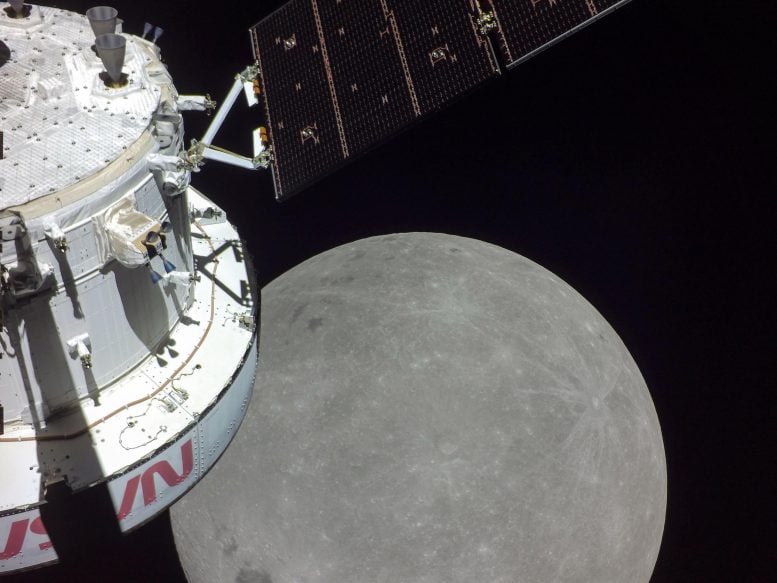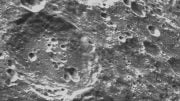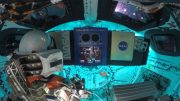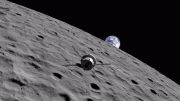
A portion of the far side of the Moon looms large just beyond the Orion spacecraft in this image taken on the sixth day of the Artemis I mission by a camera on the tip of one of Orion’s solar arrays. The spacecraft entered the lunar sphere of influence Sunday, November 20, making the Moon, instead of Earth, the main gravitational force acting on the spacecraft. On Monday, November 21, it came within 80 miles of the lunar surface, the closest approach of the uncrewed Artemis I mission, before moving into a distant retrograde orbit around the Moon. The darkest spot visible near the middle of the image is Mare Orientale. Credit: NASA
NASA Artemis I – Flight Day Six: Orion Performs Lunar Flyby, Closest Outbound Approach
On its sixth day into the Artemis I mission, Orion successfully completed its fourth orbital trajectory correction burn using the auxiliary engines at 1:44 a.m. CST ahead of the first of two maneuvers required to enter a distant retrograde orbit around the Moon. The first three trajectory correction burns provided an opportunity to fire all three thruster types on Orion with the first using the large orbital maneuvering system engine, the second using the small reaction control system thrusters, and the third using the medium-sized auxiliary engines.
Orion completed the outbound powered flyby at 6:44 a.m. CST, passing about 81 miles (130 km) above the surface at 6:57 a.m. The spacecraft’s speed increased from 2,128 mph (3,425 km/h) before the burn to 5,102 mph (8,211 km/h) after the burn. Shortly after the outbound flyby burn, the spacecraft passed about 1,400 miles (2,300 km) above the Apollo 11 landing site at Tranquility Base at 7:37 a.m. Orion later flew over the Apollo 14 site at about 6,000 miles (9,600 km) in altitude and then over the Apollo 12 site at an altitude of about 7,700 miles (12,400 km).
The Earth is seen setting from the far side of the Moon just beyond the Orion spacecraft in this video taken on the sixth day of the Artemis I mission by a camera on the tip of one of Orion’s solar arrays. The spacecraft was preparing for the Outbound Powered Flyby maneuver which would bring it within 80 miles of the lunar surface, the closest approach of the uncrewed Artemis I mission, before moving into a distant retrograde orbit around the Moon. The spacecraft entered the lunar sphere of influence on Sunday, November 20, making the Moon, instead of Earth, the main gravitational force acting on the spacecraft. Credit: NASA
“The mission continues to proceed as we had planned, and the ground systems, our operations teams, and the Orion spacecraft continue to exceed expectations, and we continue to learn along the way about this new, deep-space spacecraft,” said Mike Sarafin, Artemis I mission manager, in a November 21 briefing (see the video embedded below) at Johnson Space Center.
Orion will enter a distant retrograde orbit beyond the Moon on Friday, November 25 with the second maneuver, called the distant retrograde orbit insertion burn. The orbit is “distant” in the sense that it’s at a high altitude from the surface of the Moon, and it’s “retrograde” because Orion will travel around the Moon opposite the direction the Moon travels around Earth. This orbit provides a highly stable orbit where little fuel is required to stay for an extended trip in deep space to put Orion’s systems to the test in an extreme environment far from Earth.
NASA hosted a news conference at 5 p.m. EST on Monday, November 21, from the agency’s Johnson Space Center in Houston to discuss Orion’s outbound powered flyby burn and provide an update on post-launch assessments from the Space Launch System and Exploration Ground Systems. Artemis I Mission Manager Mike Sarafin, Flight Director Judd Frieling, and Orion Program Manager Howard Hu participated. Following a successful launch on NASA’s Space Launch System at 1:47 a.m. EST Wednesday, November 16, Orion is in orbit around the Moon as the first mission of the Artemis program. Flight controllers conducted an outbound powered flyby burn at 7:44 a.m. EST (12:44 UTC) on Monday to harness the force from the Moon’s gravity, accelerate the spacecraft, and direct it toward a distant retrograde orbit beyond the Moon. During the maneuver, Orion made its closest lunar approach, flying about 81 miles above the lunar surface. Orion re-acquired signal with NASA’s Deep Space Network, at 7:59 a.m. EST after successfully performing the outbound powered flyby burn at 7:44 a.m. EST with a firing of the orbital maneuvering system engine for 2 minutes and 30 seconds. Credit: NASA
Orion will travel about 57,287 miles (92,195 km) beyond the Moon at its farthest point from the Moon on November 25, passing the record set by Apollo 14 for the farthest distance traveled by a spacecraft designed for humans at 248,655 miles (400,171 km) from Earth on Saturday, November 26, and reach its maximum distance from Earth of 268,552 miles (432,193 km) on Monday, November 28.
As of Monday, November 21, a total of 3,715.7 pounds of propellant has been used, 76.2 pounds less than prelaunch expected values. There are 2,112.2 pounds of margin available over what is planned for use during the mission, an increase of 201.7 pounds from prelaunch expected values.
The Earth is seen rising from behind the shadowed surface of the Moon in this video taken on the sixth day of the Artemis I mission by a camera on the tip of one of Orion’s solar arrays. The spacecraft had just successfully executed the Outbound Powered Flyby maneuver which brought it within 80 miles of the lunar surface, the closest approach of the uncrewed Artemis I mission, before moving into a distant retrograde orbit around the Moon. Credit: NASA
Just after 2:45 p.m. CST on November 21, Orion had traveled 216,842 miles (348,973 km) from Earth and was 13,444 miles (21,636 km) from the Moon, cruising at 3,489 miles per hour (5,615 km per hour).
Follow along and track Orion via the Artemis Real-Time Orbit Website, or AROW, and watch live footage from the spacecraft.









Did they see Santa Claus or the workshops of the Elves?